Project Gutenberg's How to Prosper in Boll Weevil Territory, by G. H. Alford This eBook is for the use of anyone anywhere at no cost and with almost no restrictions whatsoever. You may copy it, give it away or re-use it under the terms of the Project Gutenberg License included with this eBook or online at www.gutenberg.net Title: How to Prosper in Boll Weevil Territory Author: G. H. Alford Release Date: December 23, 2010 [EBook #34729] Language: English Character set encoding: ISO-8859-1 *** START OF THIS PROJECT GUTENBERG EBOOK PROSPER IN BOLL WEEVIL TERRITORY *** Produced by The Online Distributed Proofreading Team at http://www.pgdp.net (This file was produced from images generously made available by The Internet Archive/American Libraries.)

[Pg 1]
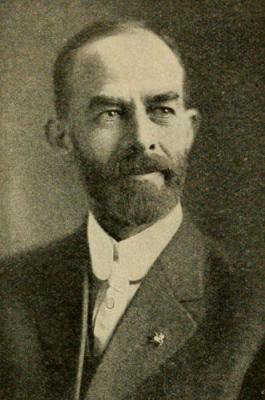
Prof. P. G. HOLDEN
Director I H C Agricultural Extension Department
Director I H C Agricultural Extension Department
“A one crop system will impoverish any country, and in turn it will impoverish the people that are on its farms. It is only through diversification of crops and the using of our energies every day of the year, as well as our hands, that we can make a great rich country and a great, strong, vigorous people.”—Prof. P. G. Holden.
[Pg 2]
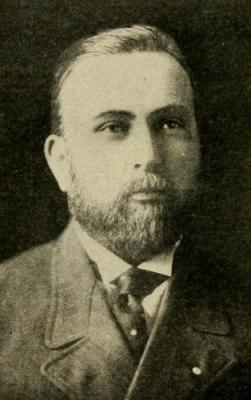
G. H. ALFORD
Of I H C Agricultural Extension Department
Of I H C Agricultural Extension Department
[Pg 3]
HOW TO PROSPER
IN
BOLL WEEVIL
TERRITORY
By G. H. ALFORD
Published and Copyrighted
by the
Agricultural Extension Department
International Harvester Company of New Jersey
by the
Agricultural Extension Department
International Harvester Company of New Jersey
Prof. P. G. HOLDEN, Director
CHICAGO, USA
CHICAGO, USA
[Pg 4]
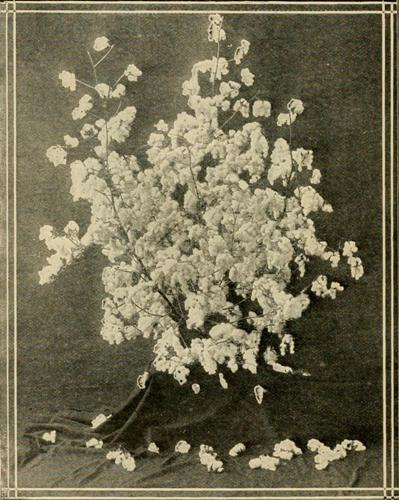
A good stalk of cotton
[Pg 5]
Introductory
This book was prepared to furnish information on farming in the boll weevil territory. Special attention has been given to the production of cotton in infested districts and to showing how to adopt a system of farming which has been found profitable by many farmers in boll weevil territories. It was written by a man who has had practical experience all his life in growing cotton in Mississippi, Louisiana and Texas. He later devoted a number of years to the special study of the boll weevil in the cotton fields of these states as special agent for the Farmers’ Co-operative Demonstration Work. In addition to this, he is acquainted with the financial and economic conditions throughout the cotton belt.
[Pg 6]
Dedicated to all Cotton Growers
[Pg 7]
How to Prosper in Boll Weevil Territory
The System of Farming Necessary to Obtain Best Results Under Average Conditions in Boll Weevil Territory
In order to obtain profitable returns from farming in boll weevil territory, we must—First, grow an early crop of cotton; second, use every means possible to destroy the weevil and reduce their number to a minimum; third, follow a system of diversified farming.
Grow an Early Variety of Cotton: To secure maximum cotton crops in spite of the boll weevil pest, the cotton grower must use every effort to bring the crop to maturity just as early in the season as possible. An early crop means profit—a late crop goes to the weevil, not to the farmer. If we are to succeed in growing cotton under boll weevil conditions we must—
1. Reduce the cotton acreage so that the most effective cultural methods may be closely followed. It is often advisable to reduce the acreage 50 per cent.
2. Plant only warm, fertile, well-drained land.
3. Thoroughly prepare the seed bed before planting. Young cotton plants do not grow well in cloddy ground.
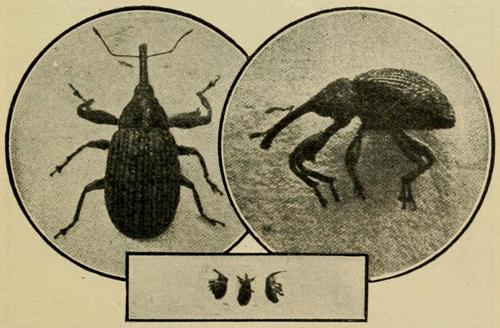
Boll Weevil; enlarged above; natural size below
[Pg 8]4. Make heavy applications of commercial fertilizer where the soil responds to such treatment, for it will hasten maturity and increase the yield.
5. Plant early, rapid-fruiting, prolific cotton seed.
6. Plant the seed as early as the season will permit, in rows just about as wide apart as the cotton usually grows tall in the average season.
7. Commence to cultivate the young cotton just as soon as possible, and do not permit a crust to form or the field to become grassy.
Reduce the Cotton Acreage: In many sections of the country, intensive farming—smaller farms and more thorough cultivation—is being profitably practiced. In boll weevil territory, we would likewise advocate “intensive” cotton growing—smaller acreage to cotton with more thorough cultivation—as a good step toward securing early and profitable cotton crops. For instance, many farmers in the boll weevil territory are now producing as much cotton on five acres by following proper methods as they formerly produced on ten acres, thus leaving half of their land to produce some other crop.
Plant on Fertile Soil: This is one of the necessities in order to produce an early cotton crop. The land must be well-drained so that it will warm up early in the spring and retain the heat. It must contain plenty of humus or vegetable matter to prevent packing. Plenty of vegetable matter also increases the water-holding capacity of the soil, thus reducing the loss due to the droughts that may occur in summer. Where the soil has not enough humus and therefore will not hold a sufficient amount of water, the cotton crop will stop growing and putting on squares during a long drought, and will shed the squares and many of the small bolls already on the stalks.
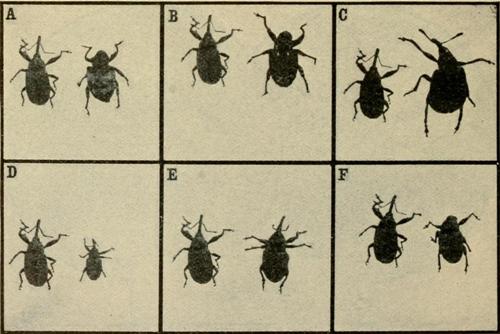
At left of each pair is a boll weevil.
The weevils at the right are weevils often mistaken for boll weevils.
The weevils at the right are weevils often mistaken for boll weevils.
[Pg 9]The soil may be kept in the proper condition of fertility for cotton by practicing a suitable rotation of crops, including legumes, and by turning under the corn stalks, the oat and pea stubble, and the grass.
Thoroughly Prepare the Soil: The soil should be plowed deep for the following reasons: First, to increase the water-holding capacity; second, to let the water escape from the surface without running over the ground and washing it off; third, to permit the air to circulate freely for a considerable depth in the soil; fourth, to secure crops against droughts by enabling the cotton roots to go down to moisture; fifth, to increase the area from which plant roots may obtain food. It is advisable to flat break the land in the fall and winter and then bed it some time before the planting season. The bed should be disked or harrowed just before planting the cotton seed, but it is seldom advisable to re-bed the land just before planting. Cotton comes up quicker, grows off faster and begins bearing sooner on a well settled, firm seed bed. It is not wise to plant the cotton on freshly prepared land.
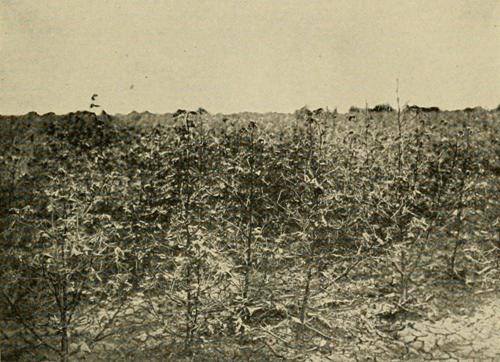
The late cotton is for weevil—not for the farmer.
The boll weevil prevented the above late cotton from making a single boll.
The boll weevil prevented the above late cotton from making a single boll.
Apply Commercial Fertilizers: Where the soil responds to commercial fertilizer, it is advisable to make heavy applications to hasten maturity and increase the yield. It is best to use fertilizers which will stimulate the fruit rather than stalk growth. High grade, 16 per cent acid phosphate is the basis for increasing fruit and hastening maturity; cotton seed meal is usually the basis for stimulating stalk growth. A mixture of two parts of 16 per cent acid phosphate and one part of 6 per cent cotton seed meal is a good mixture for cotton on soil of average fertility.
[Pg 10]It will usually also pay to mix about ten pounds of nitrate of soda with every bushel of seed just before it is put into the planter. The nitrate of soda has a tendency to cause the young cotton to grow vigorously and resist the bad effects of cool nights. It also usually pays to make a side application of nitrate of soda just after the cotton has been thinned the first time.
Plant Early Varieties: The production of an early cotton crop requires carefully selected seed of an early, rapid-fruiting, prolific variety. This seed may be purchased each year, or selected from cotton plants with low fruit limbs and short joints on the main stem and fruit limbs. With the weevil pest to combat, the value of using the earliest and most prolific seed cannot be over-estimated.
It is advisable for the average farmer to buy the best early varieties from some reputable breeder and then use every known method to increase the earliness and productiveness of the cotton. Reports of tests at the Government Experiment Stations name the earliest and most prolific varieties of cotton. It is not good business to buy varieties of seed that have not been shown to be the earliest and most prolific by actual tests in the fields through a sufficient number of years to eliminate weather conditions. Seed should not be purchased because of high-sounding names or exaggerated claims.
Plant the Seed Early: Seed should be planted just as early as the season will permit. This is important in the work of hastening the cotton crop to early maturity. The weevils do not multiply until the squares begin to form. They seldom become sufficiently numerous to destroy the squares as fast as they form, before the last of July. While it is important to plant as early as the season will permit, do not forget that cotton is a tropical plant and is badly effected by cold weather.
Cultivate the Young Cotton: Cultivation should begin before the cotton comes up. This may be done by running a steel peg tooth harrow over the field either at right angles or diagonally across the rows. This helps to let the young cotton plants through and at the same time kills millions of tiny weeds and much grass just as they are coming up. The cultivation should be repeated when the little cotton is about five days old. This early cultivation kills the grass and weeds in the sprout and forms a soil mulch all over the field, which holds the moisture in the ground, thus making the little plants grow more rapidly. Early cultivation with the harrow will reduce the necessary work with the hoe to the minimum.
If for any reason the peg tooth harrow cannot be used, the ordinary one-horse harrows should be used to stir the soil on top of the beds just before the cotton comes up. The harrow or cultivator used will kill the little grass and weeds and leave a shallow, loose layer of soil on the surface.
All later cultivation should be made with such implements as the one or two-horse cultivators, disk harrows and heel sweeps. A turning plow is out of place in a cotton field unless the soil is devoid of vegetable matter and runs together after heavy rains or unless it rains for two or three weeks and it becomes necessary to plow under the grass. If the soil packs after heavy rains, it may be advisable to use the turning plow as a necessary evil, especially, when the cotton is young. If it should be necessary to use it to loosen the soil or to clean out the crop, by all means avoid deep cultivation late in the season. Be sure to use the harrow or cultivator a few days after using the turning plow to thoroughly pulverize the stirred soil and make a dust mulch.
[Pg 11]
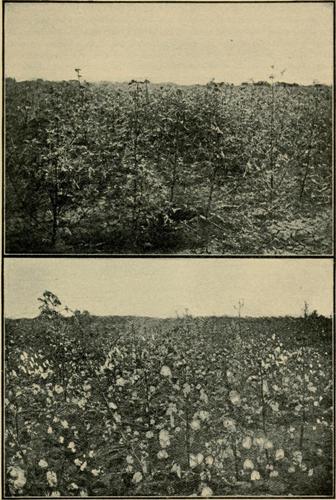
The upper illustration shows a cotton field planted late and yielding nothing.
The lower illustration shows a field on the opposite side of the turnrow on same plantation,
planted early, properly treated, and yielding three-quarters bale per acre.
(Houter, Yearbook, U. S. Dept. of Agriculture, 1906.)
The lower illustration shows a field on the opposite side of the turnrow on same plantation,
planted early, properly treated, and yielding three-quarters bale per acre.
(Houter, Yearbook, U. S. Dept. of Agriculture, 1906.)
[Pg 12]The essential thing in the cultivation of the cotton is to keep the ground free from grass and weeds and covered with a soil mulch. Frequent and shallow cultivation should be continued until the cotton begins to open. Most of the benefits of thorough preparation, early, rapid-fruiting seed, early planting and intensive, shallow cultivation may be lost unless the fields are given the utmost attention until the cotton begins to open. Frequent and shallow cultivation late in the season will not result in the death of many adult weevils, but it will knock many punctured squares to the hot ground and cause the cotton to remain green and continue to grow and put on squares to furnish food for the boll weevil. The boll weevil prefers squares to bolls and as long as the cotton puts on sufficient squares to furnish it with the necessary food it will not attack many bolls.
Avoid deep cultivation late in the season, especially close to the cotton. If the plows cut the roots and cause the cotton to cease to put on squares the weevil will at once attack the bolls, which would otherwise not be injured.
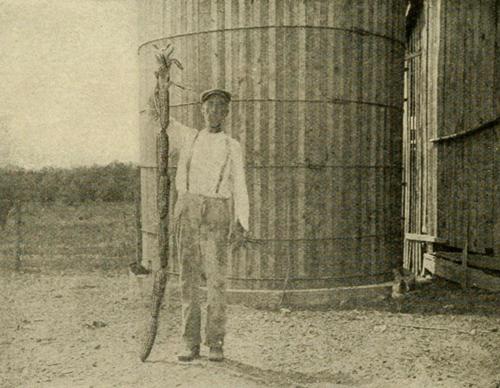
More and better corn must be grown in weevil territory.
Above corn grown on I H C farm, Brookhaven, Miss.
Above corn grown on I H C farm, Brookhaven, Miss.
[Pg 13]
How to Reduce Boll Weevil
Best Methods of Reducing the Number of Weevil to a Minimum—Results of Many Experiments Conducted
Remarkable results and profitable returns have been obtained by carefully applying the following methods of destroying the boll weevil:
1. Completely strip the cotton stalks of foliage, squares, and bolls—the weevils’ sole food supply—plow the cotton stalks under good and deep, or burn them at the earliest possible moment.
2. During the winter, destroy the rubbish in and about the fields, which might serve as hibernating quarters for weevils.
3. When the weevils appear on the new cotton in the spring, pick them off and destroy them.
4. Pick up all punctured squares and destroy them for at least one month after the first squares form on the cotton.
Importance of Destroying the Food Supply: The most important step in producing cotton in boll weevil territory is the early fall destruction of the foliage, squares, and immature punctured bolls on the cotton stalks, which constitute the weevils’ only food supply. Thousands of experimenters, including the United States Bureau of Entomology, Government Agents in Farm Demonstration Work, the Louisiana State Crop Pest Commission, and thousands of successful farmers substantiate this statement that the early fall destruction of the cotton stalks is the most effective method that can be employed for the reduction of the number of weevil.
An experiment conducted by the Bureau of Entomology in Calhoun County, Texas, showed that where the stalks on 410 acres of land were destroyed early in October, that the yield was increased $14.56 per acre. Another experiment was conducted on opposite sides of the Guadaulope River near Victoria, Texas. The stalks were burned on one farm the latter part of September and on the other they were allowed to stand until planting time. Forty acres, on the farm on which the stalks were destroyed, produced fifteen bales of cotton. Forty acres on the other farm made three and one-half bales.
Experiments conducted by the Louisiana State Crop Pest Commission are summed up in the following extracts from Circular No. 28: “Where the cotton plants were destroyed before October 15, only 3 per cent of the weevils survived the winter to infest the next year’s crop. Where the stalks were destroyed from October 15 to October 27, an average of about 15 per cent of the weevils passed through the winter successfully. Where the stalks were destroyed between November 1 and November 25, an average of approximately 22 per cent of the weevil survived the winter. Postponing the fall destruction of cotton stalks until the middle of December, or later, permitted[Pg 14] over 43 per cent of the weevils to survive the winter and attack the next crop.” Where the stalks were destroyed before October 15, only 3 per cent of the weevils passed the winter. Where the stalks remained in the field until December 15, over 43 per cent of the weevils survived the winter. These figures certainly emphasize very strikingly the value of early fall destruction of the boll weevil’s food supply.
Methods of Destroying the Food Supply: With the importance of early fall destruction of the cotton stalks fully realized, the cotton grower has before him the question of how best to accomplish this. There are three methods of destroying the squares, bolls, and foliage of the cotton stalks: 1. Pasturing; 2. Plowing under; 3. Burning.
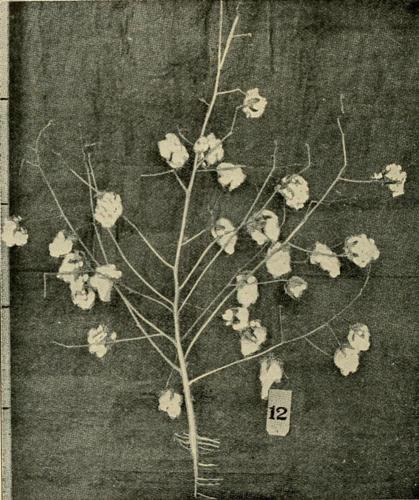
A mature cotton plant that was late in fruiting.
The joints are long and the balls far out from the center and base of the stalk.
The limbs have few joints and few bolls.
Height of plant, 3 feet; balls 26—10 in lower half circle.
Do not plant this type in weevil territory.
The joints are long and the balls far out from the center and base of the stalk.
The limbs have few joints and few bolls.
Height of plant, 3 feet; balls 26—10 in lower half circle.
Do not plant this type in weevil territory.
[Pg 15]Pasturing the cotton fields is a good method of destroying squares, bolls and foliage where the cotton fields are fenced and where a sufficient number of cattle can be turned into a field to eat all the squares, bolls, and foliage in a few days. However, let it be distinctly understood that the practice of turning just a few head of cattle into a fifteen or twenty acre cotton field accomplishes no particular good. Every cotton grower knows from his own observation that two or three head of cattle to an acre, even when confined entirely to the cotton field, will eat very little of the green foliage in one week, and it must be kept in mind that it is vital to destroy as quickly and as completely as possible the food supply of the mature weevils and the breeding places of the immature weevils.
Plowing cotton stalks under is an effective method of destroying the food supply of mature weevils and ending the lives of immature weevils where there are few stumps and roots, where the cotton stalks are small, and where large plows and strong teams can be had. Farmers who have attempted to plow under green cotton stalks early in the fall, laugh at the advice sometimes given to plow under the stalks at all times and under all conditions as a means of destroying the food supply of the weevil. They know from experience that such advice is often better theory than practice as the plowing under of green cotton stalks is very often a decidedly obstinate proposition. However, where large plows and strong teams are available, use them and completely bury the cotton stalks wherever it can be done.
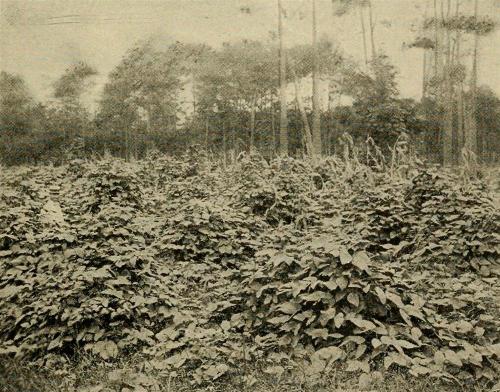
Velvet beans yield abundant crops and add nitrogen to the soil. A good crop for weevil territory.
[Pg 16]Burning the stalks is a practical method of destroying the weevils. On many farms and plantations there are not cattle enough to strip the cotton stalks thoroughly and completely of every particle of foliage, squares and bolls in a short time by pasturing. It is also often impossible to completely bury the cotton stalks. In such cases, it is absolutely necessary to cut, dry and burn them as soon as the cotton can be picked. By burning the stalks, the food supply of the adult weevil is destroyed, and weevils in immature stages in the squares and bolls are destroyed. A large majority of the adult weevils also perish in the flames, especially when the stalks are burned after sundown, as weevils retire to the stalk piles for the night at about that time. They seldom move about at night, and if care is taken not to disturb them when applying the torch, practically all will be destroyed.
Of course, if the stalks are allowed to remain until a heavy frost has come, practically all of the mature weevils will have gone into winter hibernating quarters and the immature weevils in the squares and small bolls will have been frozen. Nothing will be gained in that case by burning the stalks and the best thing that can be done will be to cut the stalks and turn them under as deeply as possible.
Clean Up Hibernating Quarters: Many weevils escape from the fields but all do not fly beyond the reach of the farmer. Surprising numbers have been found hibernating in cracks and holes in the ground and under grass, weeds and other trash. In January, 1907, in one instance, the United States Bureau of Entomology found 5,870 weevils per acre of which 70 per cent were alive. Most of the many examinations that have been made have shown more than one thousand live weevils per acre in the cotton fields. Many are found along the fence rows, hedges, ditch banks and in decayed logs and dead trees. Thousands more are found hibernating in nearby cornfields and old sorghum, cane and hay fields.
Winter plowing of all cultivated fields is therefore another effective way of reducing the number of weevils, as the thousand or more weevils per acre in the cracks and holes in the ground and under the grass, weeds, trash and cornstalks can practically all be killed by deep winter breaking.
Picking Off the Weevils: After the hibernating weevils emerge from their winter quarters in the spring and reach the young cotton, there is little further movement until the general dispersing season in August, September and October. The fact that the weevil does not move about much except in the fall makes it possible for the individual farmer to accomplish results from his own efforts in fighting the pest. There is little danger of weevils coming in from other fields until in August, by which time the cotton crop is normally set. For this reason, there need be no fear that time will be wasted which is spent in thoroughly picking off the weevils from the young cotton plants before the squares begin to form.
Where the food supply of the weevil has not been destroyed early in the fall and strength added to this blow by plowing under the corn stalks, trash, weeds and other vegetable matter that serve as hibernating quarters, and by destroying practically all of the weevils hibernating along the fence rows, hedges and ditch banks, the over-wintered weevils are often sufficiently numerous to puncture all the squares as fast as they form. Where this is the case, no bottom crop and seldom a middle crop of cotton will be made unless the weevils are picked off and the punctured squares destroyed.
[Pg 17]

An early cotton plant. The fruit limbs are low and close together on the stalk and the joints are short.
Plants of this structure fruit early, rapidly and are well adapted to boll weevil conditions.
Plants of this structure fruit early, rapidly and are well adapted to boll weevil conditions.
[Pg 18]The possible progeny of a single pair of weevils, during a season, has been estimated at 12,755,100. Nature has provided a number of agencies to prevent such excessive multiplication; nevertheless, the picking off of a single pair of weevils from the young cotton plants may mean millions less later on.
Before squares form on the cotton, the over-wintered weevils that have come out of winter quarters feed on the opening leaves or buds of the young cotton plants. Early in the morning it is an easy matter to find the weevils in the buds, where they can be easily picked off and destroyed.
The only reason why the weevils cannot be eradicated by thoroughly picking them off, is that large numbers of over-wintered weevils do not emerge until after the squares begin to form. As soon as the squares form, the weevil gets on the inside of the bracts and feeds only by inserting its beak deep into the squares. After the squares begin to form, it is hardly practicable to pick the weevils off.
Destroy All Punctured Squares: The weevils that survive the winter are all in the adult stage. They breed only in the squares and bolls and therefore cannot multiply until squares form. The most conspicuous indication of the presence of the boll weevil is the flaring of the square. When the weevil punctures a square, it turns yellow and the bracts flare open. The punctured squares usually fall to the ground in a few days.
The over-wintered weevils live only a few weeks after coming out of winter quarters in the spring, as they die shortly after breeding in the squares and bolls. Therefore, if the young cotton plants are thoroughly picked two or three times just before the squares begin to form, and every punctured square is destroyed for at least one month after the first squares form, practically all of the over-wintered weevils will be dead and hence there will be few young weevils later on. If it were possible to destroy every punctured square and boll, and thereby prevent the appearance of new broods, the weevil pest could be exterminated in one year. At any rate, the results that can be accomplished behoove every farmer to work carefully and painstakingly to destroy all the punctured squares possible before the new broods of weevils are hatched.
During the growing season, many weevils can be destroyed by co-operating with the natural agencies that tend to reduce their number. For instance, the weevils in the punctured squares that fall on the hot ground in July and August and are not shaded, are usually killed at once by the heat or will starve for lack of food, because of the hardening of the square. By using a brush on the cultivators to agitate the plants when cultivating the crop, many punctured squares will be knocked off onto the hot ground sooner than they would naturally fall off. At the same time, some of the adult weevils will also be shaken off onto the hot ground. When an adult weevil is thrown on a surface of finely pulverized, hot soil, it is killed almost instantly.
Attempts to Destroy Weevils with Poison: In territory newly infested with the boll weevil, attempts continue to be made to destroy the weevils by poisoning. Of course the farmers soon learn better, but the[Pg 19] experience is very expensive. If advocates of poison would only remember that after the squares begin to form on the cotton, the boll weevils feed only by inserting their beaks deeply into the squares or bolls, they would realize that it is impossible to place poison where the weevils will feed upon it. In all the experiments performed in the field by the United States Bureau of Entomology, very heavy applications throughout the season have failed to show any advantage in the use of poison. Therefore, do not waste any money on poisons.
Not Attracted by Light: The weevil seldom moves at night. It is inactive after sundown. The weevil is never attracted to lights and hence the use of a trap lantern has no effect on them.
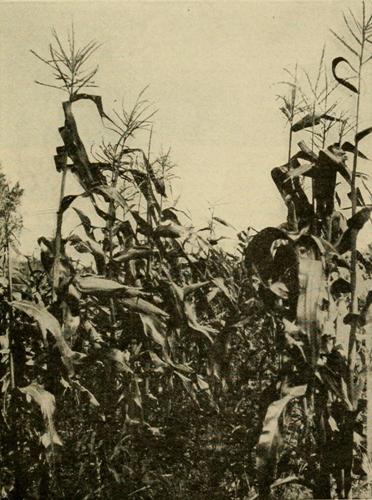
Good corn must be grown in weevil territory.
[Pg 20]
The Cotton Boll Weevil
Its History, Habits, Food Supply and Life Rate of Increase and Damage Done to Crops
History: The cotton boll weevil is not a native of the United States. It came from Mexico in 1892. It may have flown across the Rio Grande River near Brownsville, Texas, or it is possible that it was carried across in seed cotton. Since 1892, it has extended its range annually from fifty to one hundred and twenty-five miles until it has spread over Texas, Oklahoma, Louisiana, Arkansas, Mississippi and a part of Alabama.
Life and Habits: The eggs are laid within the squares and bolls of the cotton plant. The weevil prefers the squares and seldom punctures a boll as long as there are numerous squares to puncture. The mouth of the adult weevil is located at the end of the snout. The weevil eats a small hole into the square or boll and then turns around and deposits one egg in the puncture and seals the hole with a small drop of a gluey substance to protect the egg from ants, rain and other destructive agencies. The weevil seldom deposits more than one egg in a square or boll until the squares and bolls become very scarce. The egg hatches in from three to fifteen days, depending on the temperature. The larvae is a tiny white footless grub, with a brown head and dark jaws. This grub feeds on the inside of the square or boll and passes into the pupae stage in from six to twelve days. The adult or mature weevil develops from the pupae stage in three to ten days and eats its way out of the square or boll.
How to Know a Boll Weevil: The safest plan for one who is not well acquainted with the boll weevil is to send any doubtful specimen to an entomologist or to a government expert. There are a few characteristics, however, that will assist anyone in separating the boll weevil from the numerous other weevils that are often mistaken for it. On each front leg of the boll weevil are two spines—one somewhat larger than the other. The snout has a black shining appearance and the “feelers” are near the outer end. The boll weevil is usually from one-fourth to three-eighths of an inch long and about half as broad. When they first come from the square or boll, they are almost pink but rapidly turn darker until they are of a dark brown or chocolate color.
Weevils’ Food Supply: The foliage, squares and bolls on cotton stalks constitute the weevils’ sole food supply. The Mexican cotton boll weevil never feeds upon okra, peas, beans or other plants unless captured and placed in confinement and then only to a slight extent.
Rate of Increase: The weevils that survive the winter begin to lay eggs when the first squares form on the cotton and successive broods continue to lay eggs until checked by heavy or killing frost in the late fall. Observations made by Drs. W. D. Hunter and W. E. Hinds, show that the female weevil deposits eggs at the rate of from three to five per day and continues to lay eggs for an average of twenty-eight days. The following is a quotation [Pg 21]from Dr. W. D. Hunter, government entomologist in charge of the boll weevil work in the South: “A conservative estimate of the possible progeny of a single pair of weevils during the season beginning on June 20 and extending to November 4 is 12,755,000.”

Larvae of boll weevil in cotton square
Life Period of Weevil: Weevils born during the early summer live from fifty to seventy-five days. Weevils that are born late in the fall hibernate and large numbers live through the winter and for about twenty days after emerging in the spring.
Hibernation: The immature weevils in the squares and bolls are usually killed during the winter. All adult weevils become dormant and the well protected weevils usually live through the winter and do great damage in the spring. The adult weevil spends the winter in hedges, broomsedge, woods, hay stacks, farm buildings, decayed logs, moss and dead trees.
[Pg 22]
Rotation of Crops
A Safe and Sane System of Crop Rotation in Boll Weevil Territory Absolutely Necessary
When the boll weevil first appears in a territory, the first efforts at breaking away from all cotton usually consist in going largely into another single crop system of farming rather than the production of a variety of crops. The evils of the new system are usually as great as those of the all cotton system. Many farmers rush into the truck business. Of course, truck crops should be grown on every farm in the weevil territory, and, in some particular localities, they may constitute the main reliance for cash, but it seems that the truck business is a gamble for the average cotton farmer. Trucking has lured many a farmer to financial ruin.
The crop rotation for the average cotton farmer should include oats, corn, some cotton, and at least one leguminous crop. Along with this should go the growing of hogs, mules, horses and cattle instead of having to buy them from other sections of the country.
It is not possible for the farmer in the boll weevil territory to entirely supplant cotton as a money crop, but this crop should be supplemented with the growing of home supplies, as well as other crops which will produce cash returns.
Cotton is one of the greatest cash crops, and while it should be the main money crop in the boll weevil territory north of latitude 32, it should not be the only cash crop grown. The safest plan either within or without the boll weevil territory is to follow a system of diversified farming. The cotton farmers, especially those in the boll weevil territory, cannot afford to depend entirely on cotton as a cash crop. A system of rotation suitable for cotton belt farmers should include some of the following staple crops:
Oats are probably the surest and best paying small grain crop that can be grown over practically the entire cotton belt. The same soil that will produce one bale of cotton per acre will grow 60 bushels of oats. At the average price that has prevailed for oats during the past five years, the 60 bushels will sell for $36 to $40, and the straw, when baled, will often pay the larger part of the expense of growing the grain.
The bale of cotton per acre land will produce about $30 worth of oats, at least one and a half tons of lespedeza hay, and five bushels of lespedeza seed. The lespedeza hay will sell for about $12 per ton and the lespedeza seed for about $3 per bushel. The total is $63 per acre. We are personally acquainted with a farmer who has averaged $65 per acre for eight years.
Thirty dollars worth of oats and twenty bushels of soy beans at $1.50 per bushel, and one and a half tons of soy bean hay at $8 per ton, means $72 per acre. These are very conservative figures. At the Mississippi Delta Experiment Station in 1912 the land produced ninety bushels of oats to the acre, twenty-two and a half bushels of soy beans, “after losing a good percentage of the beans by shattering,” and 5,200 pounds of soy bean hay. The average yield of cotton on the same land was about 500 pounds of lint per acre.
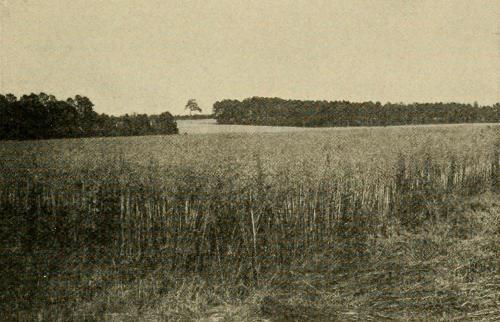
Oats in a three-year rotation with cotton and corn
[Pg 23]Oats and vetch sown together furnish more and better grazing and better hay than either when sown separately. There is no better hay than oats and vetch cut in the dough stage. Few hays will sell for a better price on the market. The oat and vetch hay provides a much more satisfactory ration for horses and mules than corn or leguminous hay.
Oats may be followed by cowpeas. When the cowpeas are planted in rows on good land, well fertilized and cultivated, the yield is usually from ten to twenty bushels of peas and one and a half tons of hay. The peas usually sell for about $2 per bushel and the hay for about $12 per ton.
Ninety bushels of oats and sixty-seven bushels of peanuts were produced on the same land at the Mississippi Delta Experiment Station in one year. At the present prices for peanuts and peanut hay, it is a very profitable crop to grow after oats when properly handled.
When corn is planted on fertile soil thoroughly prepared, properly fertilized and cultivated, the yield is usually about fifty bushels per acre. The average price per bushel is about 80 cents. Peas planted in corn at the last working will usually average about eight bushels of peas and a ton or more of valuable hay. The peavine hay can be harvested by live stock.
The growing of live stock will help to create extensive home markets for roughage and leguminous crops, keep the money at home that is usually sent to the north and west for pork products, mules, horses, hay, beef, and so on, and at the same time add greatly to the fertility of the soil. Pork can be produced in the cotton belt more easily than any other live stock. It would not be wise for the average cotton farmer to devote his farm exclusively to hog raising, yet it will certainly pay him to produce enough pork for home use and some to sell to supplement the money formerly obtained for cotton.
Chickens, turkeys, ducks and other poultry sell for good prices and every cotton farmer in the weevil territory should raise some poultry for sale.
[Pg 24]
The Labor Problem
Plenty of good labor is an absolute necessity in growing cotton under boll weevil conditions. The tendency of newly infested districts is to neglect the laborer at the time when he needs support and encouragement. Thousands of families have moved out of a single county in one season to other cotton sections, while if they had been given a little encouragement to grow corn, grain, cowpeas, hogs, vegetables in his own garden, etc., he would have remained in the community where he is much needed.The farmers, planters, merchants and bankers must unite and see to it that the laborers have the actual necessities of life. He should be encouraged to grow his home supplies, a little cotton, a few chickens and his own pork. This method would put farming on a basis which will eliminate and do away with the necessity of sending to the north and west for bacon, lard, mules, corn, hay and other supplies. By working together and keeping our laborers satisfied we will keep them in the community where they are needed to till the soil and help build up our farms.
The Debt Problem
When traveling in weevil territory, we meet farmers almost daily who are anxious to sell their farms at from one-third to one-fifth of their real value. The farmers tell us that they are in debt and will never be able to pay out. They say that the boll weevil has come to destroy their cotton—their sole cash crop.Now these farmers are mistaken on two counts. First, cotton is not the only surplus money crop; second, the boll weevil does not prevent the growing of profitable crops of cotton in normal seasons. The cotton money is now used to pay for corn, bacon, lard, mules and hay. When the tenants and farmers all live at home and practice the most rigid economy, the cotton money will soon pay all debts.
Life on the farm is robbed of practically all of its pleasures as long as we pay fifty per cent credit profits and the creditor constantly knocks at the door. The only people who really suffer in periods of hard times are the men who are in debt; men who owe money and are often compelled to sacrifice their property to meet the imperative demands of their creditors. The farmer who is out of debt when the boll weevil comes and has an abundance of high class food supplies on his farm is not materially affected. Many of the cotton farmers who are in debt when the boll weevil comes lose their homes.
Labor Saving Implements
The following is an extract from an address delivered at Greenville, Miss., in the boll weevil territory, by Dr. S. A. Knapp, a man who did more for real genuine progress in the South than any other one man has ever done. “The farmer who uses modern machinery in planting and cultivating his crop will succeed, and the one who does not will make a failure. The old way of making a crop by hand by the use of the hoe and plow must soon be a thing of the past. We must come to use the modern implements and the sooner we let the negro understand that he must work his crop in this way, the better off we shall be.”[Pg 25]
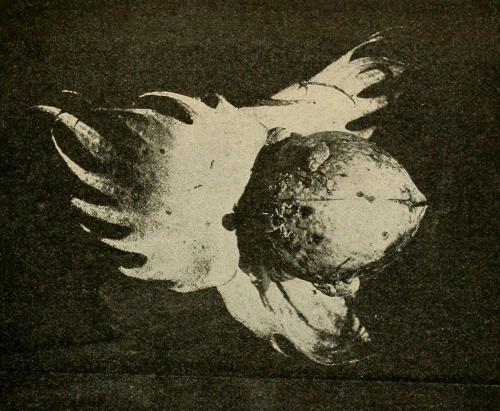
Boll weevils attacking growing cotton boll
The Personal Element in the Boll Weevil Fight
By B. L. Moss
Editor Progressive Farmer, Birmingham, Alabama.
Editor Progressive Farmer, Birmingham, Alabama.
A man’s personal attitude and convictions play a large part in his successes and failures in all walks of life, and nowhere is the truth more apparent than in a farmer’s attitude toward the boll weevil problem.
Before the coming of the weevil, it is looked upon by nine farmers out of ten as a remote danger, doubtful in time of arrival and greatly exaggerated in its possibilities for damage. No preparations for it are made, the farm mortgage is left hanging like a cloud over the family homestead, and the old methods so long in vogue are left unchanged.
Then the crash comes! The obsolete methods of the past are worthless against the weevil; the cotton crop is swept away, interest on the mortgage is unpaid, and its foreclosure is certain. This picture is the rule and not the exception.
Such a situation calls forth the real qualities of the man. Many a farmer, for the first few years of the weevil invasion, has proven a quitter. He has failed because he did not think he could succeed. Usually he has been the identical man who failed to believe in and prepare for the coming of the weevil.
The exceptional man has believed in and prepared for the weevil’s coming, and he has succeeded. Incidentally, his success has shown out as a beacon light to his doubting neighbors and has ultimately pointed the way for them.
[Pg 26]Five years’ experience tells me that you can raise cotton profitably in the presence of the boll weevil. The HOW of the matter is given by others in this booklet, but you, YOU, must take it up with the spirit of FIGHT. Believe that you can, swear that you will, and success is yours.
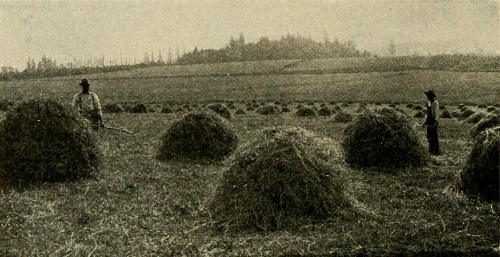
Lespedeza a great hay crop for the lower South
The Boll Weevil’s Influence in the Regeneration of the South
By H. Guy Hathorn, Planter, Woodville, Miss.
For many years the one crop system has been the bane of the cotton belt. When land was virgin, cheap and plentiful, the evil was not so apparent, and the necessity for a saner system was not so pressing. A depleted soil, unreliable labor and various other factors caused certain individuals to see the error of their way, and induced them to adopt a diversified system and the use of labor-saving implements. It was necessary for the great majority to receive a paralyzing shock before they would make any material change; that shock came in the shape of the boll weevil. As certain alternative medicines create great debility and languor of the body before the curative power can become operative, so has all business in any way connected with the growing of cotton suffered depression as a preliminary to the greater financial vigor and strength that comes after a few years’ experience with stock raising and diversification as the rule, and with cotton occupying a secondary place in the farm operation.
[Pg 27]
Letter from the Late Dr. S. A. Knapp to G. H. Alford
Of course the heavy rains have been favorable to the weevil, and nothing else could have been expected in weevil territory than the weevil should appear and be rather plentiful on the young cotton. But our experience in this boll weevil fight is that it is far better to have a wet period at this time than later, when the plant is much larger and the squares more numerous. The farmer is inclined to look at the dark side of things. This early rain is rather a favorable symptom than otherwise because, in all probability, it will clear off and be warm and dry. In 1907 we had just such a period of rain a trifle later than this. It cleared off and in a few weeks nine-tenths of the weevil, so far as reported, had disappeared. The man who energetically clears out his cotton as soon as the weather permits and strictly follows our plan of intensive cultivation, will be quite sure to make a fair crop.
We are not afraid of these early rains; it is the late rain, because if the planter now follows our plan and picks up the squares for a month, the weevils will be pretty nearly exterminated. In fact, if everybody would do it the weevil would do very little damage. But when there is a period of continuous rain after the plant has nearly matured, it is a much more difficult problem to handle. The sun has less access to the plant and it is more difficult to secure all the fallen squares.
The greatest problem with which we have had to deal in boll weevil territory is the hopeless view of the farmer. He wants to plow up his cotton and put in something else, or he refuses to give his cotton the attention which it requires. If he follows our plan thoroughly he will succeed, and in future will make his crop hopefully as he did before the boll weevil appeared.
Picking Weevils and Squares
The following is the substance of a number of letters from Mississippi farmers relative to picking weevils and squares: Mr. T. L. Rush says that the first time he caught an average of fifty weevils per acre and the second time twenty-eight. The cost of picking the weevils was about fifty cents per acre. He gathered the punctured squares seven times at a cost of about $2.50 per acre. Mr. C. S. Rowland picked the weevils and squares on thirty-five acres of cotton at a cost of $43.60. Mr. J. W. Shelton picked an average of sixty-five weevils per acre off his little cotton for four weeks at a cost of 25 cents per hundred. Mr. J. M. Crawford found 268 weevils the first time; two hundred and fifty the second time, one hundred and ninety-seven the third time and one hundred and fifty the fourth time. He gathered one bushel of squares the first time and three bushels a second time. The cost was about $20.00 on the ten acres. Mr. A. W. Harrell picked over two acres of cotton three times and got one hundred and fifty weevils and seven hundred squares. It cost him about $2.00 per acre.[Pg 28]
Profitable Farming in South
G. H. Alford, one of the agents of the government representing the agricultural department, talked to business men and planters at the Vicksburg Cotton Exchange last week and said some good things, among them the following:
“The planters who keep their laborers and force them to grow plenty of corn, rice, potatoes, molasses, hogs and poultry for home use and to cultivate say six or seven acres of cotton, according to government instructions, will grow more prosperous every year. They will not grow as much cotton, but it will not be necessary for them to send two-thirds of the money obtained for cotton to other sections of the country to pay for farm products. Boll weevil or no weevil, prosperity will be the rule in Warren county when all of her people live on the products of the farms and grow cotton as a surplus crop. I meet planters every day who are anxious to sell their plantations. They tell me they are in debt and will never be able to raise the mortgage. They say that the boll weevil is here to destroy cotton—their money crop. They are mistaken on two counts. Profitable crops of cotton can be grown in spite of the boll weevil and cotton is not now a surplus money crop. They will grow profitable crops of cotton as a surplus crop in a year or so. They will then all live at home and grow say two-thirds as much cotton. The cotton money will then raise the mortgages instead of paying for corn, bacon, lard, mules, hay, etc. The boll weevil means diversified farming and stock raising. This means fertile soil and good farming. Fertile soil and good farming means high priced land. The boll weevil will probably keep the price of land down for two or three years, but diversified agriculture and the raising of good hogs, cattle, mules, horses and other stock will force the price up and up until it will sell for four or five times its present market value. Let every planter hold a tight grip on his land. There is no excuse for the blues. The northern farmers are getting rich. They cannot grow cotton. They cannot grow sugar cane, rice and many other crops that can be grown in Warren. Any crop will grow here that the northerners can grow. Diversified farming and stock raising and the growing of cotton as a surplus crop will put Warren county on the high road to genuine prosperity.
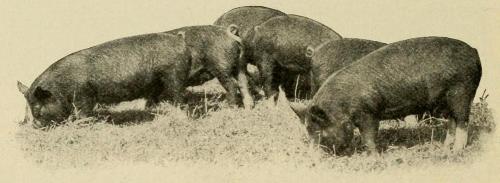
Pigs idea of heaven
[Pg 29]
A Very Instructive Letter
Letter from C. R. Byrnes, Natchez, Miss., to G. H. Alford: “We are just closing our second year of serious disaster from this little pest. We show a decided improvement in 1910 over the year of 1909. Our acreage is about one-half of what it was last year and we will make about the same crop as last year. In my individual case, I made last year seventeen bales on 150 acres; this year I will make the same crop on eighty acres. You are aware that I do not live on my own farm and have only negro tenants. I have directed the management by not exceeding two visits to the farm each week during the working season and have followed the government’s directions as well as I could, situated as I am. If I had lived on my farm far better results could have been obtained. I have now more corn than I will require for next year’s crop and a good start of hogs and cattle. My farm has been more than self-sustaining this year and I believe I will have a splendid return next year, as I have so little to buy.
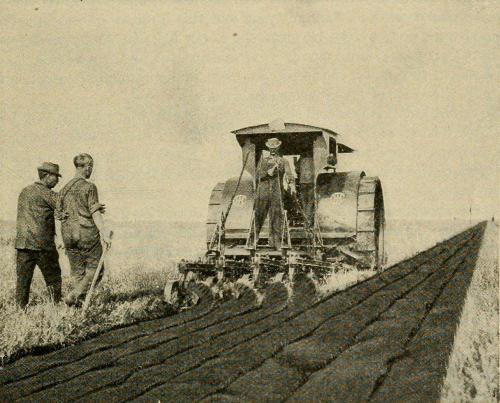
A tractor turning four furrows
My success is due to the aid of Government instructions. To illustrate: One of my negro tenants, when I told him in the month of May that he must send his entire family into his cotton patch and pick every punctured square from the cotton stalks and burn them and also kill the weevils to be found, objected; said he did not believe in it. I replied that the instructions were not original with me, that they were from the United States Government, after a fifteen years’ study of the boll weevil, and if he thought he knew more[Pg 30] about it than the Government I would try to place him in the employ of the Government and get one of their men to come and work his crop under his, the tenant’s, direction. This remark had the desired effect. He got the weevils and will make three bales of cotton on eight acres, while he made only one and one-half bales on sixteen acres last year.
Being a member of our Board of Supervisors, I insisted that our President, manager of the convict farm, plant five acres in cotton and work it under Government’s instructions. He was opposed to planting any cotton. I insisted on it, stating that I was not after the money it would bring, but wanted it as an experiment and aid to our farmers, knowing that the labor was there under absolute control, and that there would be no reason why it could not be properly farmed. The five acres were planted and properly worked—two heavy bales have been ginned and another light bale will be picked. Now this was on thin upland, fertilized and worked as you would have directed. Splendid results, is it not?
You are aware that this year and last year gave us too much rain in our section to successfully combat the weevil, but we have doubled the yield under similar conditions for each year and this increase is certainly due to the good work done by the Government in our behalf. Many more farmers will next year follow more closely your instructions and if we can get a normal season as to rainfall, the cotton crop will, in my opinion, show much more decidedly the value of the Government’s work.
No doubt but this pest will spread until it covers the entire cotton belt of the south. I can see work for you all the way to the Atlantic Seaboard—work in front of you and work behind you. Have you ever thought what a barren waste there might have been in the wake of this little giant were it not for the valuable assistance rendered by our Government? As it is we cover up his tracks almost as fast as they are made. Stand by us until we are able to stand alone. Then you and all connected with you in this good work will forever have the heart-felt thanks of all the farmers here.”
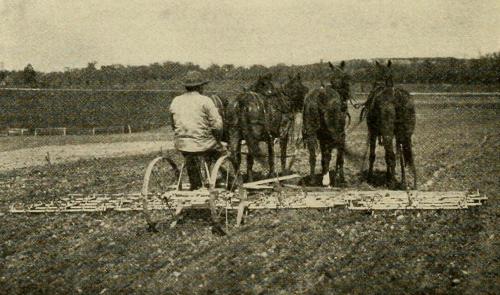
The modern method of preparing the soil
[Pg 31]
Boll Weevil Literature
U. S. Senate Document 305, and Farmers’ Bulletins 51, 74, 209, 211, 314, 344, 512. Published by U. S. Department of Agriculture, Washington, D. C.
Knapp’s Method of Growing Cotton by H. E. Savely, and W. B. Mercier. Published by Doubleday, Page and Company, Garden City, N. Y.
Southern Field Crops by J. F. Duggar. Published by the Macmillan Co., New York.
Numerous publications may be obtained from the Louisiana Crop Pest Commission, Baton Rouge, La.; the Texas A. M. College, College Station; the Mississippi A. M. College, Agricultural College, Miss., and the Alabama A. M. College, Auburn, Ala.
Knapp’s Method of Growing Cotton by H. E. Savely, and W. B. Mercier. Published by Doubleday, Page and Company, Garden City, N. Y.
Southern Field Crops by J. F. Duggar. Published by the Macmillan Co., New York.
Numerous publications may be obtained from the Louisiana Crop Pest Commission, Baton Rouge, La.; the Texas A. M. College, College Station; the Mississippi A. M. College, Agricultural College, Miss., and the Alabama A. M. College, Auburn, Ala.
[Pg 32]
I H C Booklets
These booklets will be sent to any address upon receipt of the amounts named below. Quantity lots are sent transportation charges collect.| NAME | Single Copies Each | Quantities Each |
| The Story of Bread | $0 03 | $0 02 |
| The Creeds of Great Business Men | 05 | 03 |
| Getting a Start with Alfalfa in the Corn Belt | 02 | 01 |
| Lecture Notes for Alfalfa Charts | 04 | 03 |
| Studies in Alfalfa | 04 | 03 |
| Alfalfa Sermon | 02 | 01 |
| Sweet Clover | 04 | 03 |
| Seed Corn | 03 | 02 |
| Alfalfa in the Cotton Belt | 02 | 01 |
| For Better Corn in the Cotton Belt | 02 | 01 |
| Diversified Farming in the Cotton Belt | 04 | 02 |
| The Boll Weevil | 04 | 03 |
| The Cattle Tick | 02 | 01 |
| For Better Crops in the South | 04 | 03 |
| I H C Demonstration Farms in the South | 02 | 01 |
| For More and Better Corn in the Northwest | 02 | 01 |
| Poultry Book | 02 | 01 |
| The Golden Stream | 05 | 02 |
| The Disk Harrow | 04 | 02 |
| For Better Crops | 06 | 03 |
| Engine Operator’s Guide | 03 | 02 |
| The Story of Twine | 03 | 02 |
| Binder Twine Industry | 20 | 15 |
| Harvest Scenes of the World | 50 | 35 |
| “The Rag Doll” for Testing Seed Corn— Cloth, each 10c; per dozen, 75c. Paper, per dozen, 5c. Plans and Specifications for Farm Buildings, per plan, 5c. | ||
Agricultural Extension Department
Harvester Building
Chicago, Ill.
Harvester Building
Chicago, Ill.
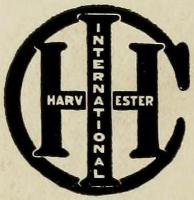
End of the Project Gutenberg EBook of How to Prosper in Boll Weevil Territory, by
G. H. Alford
*** END OF THIS PROJECT GUTENBERG EBOOK PROSPER IN BOLL WEEVIL TERRITORY ***
***** This file should be named 34729-h.htm or 34729-h.zip *****
This and all associated files of various formats will be found in:
http://www.gutenberg.org/3/4/7/2/34729/
Produced by The Online Distributed Proofreading Team at
http://www.pgdp.net (This file was produced from images
generously made available by The Internet Archive/American
Libraries.)
Updated editions will replace the previous one--the old editions
will be renamed.
Creating the works from public domain print editions means that no
one owns a United States copyright in these works, so the Foundation
(and you!) can copy and distribute it in the United States without
permission and without paying copyright royalties. Special rules,
set forth in the General Terms of Use part of this license, apply to
copying and distributing Project Gutenberg-tm electronic works to
protect the PROJECT GUTENBERG-tm concept and trademark. Project
Gutenberg is a registered trademark, and may not be used if you
charge for the eBooks, unless you receive specific permission. If you
do not charge anything for copies of this eBook, complying with the
rules is very easy. You may use this eBook for nearly any purpose
such as creation of derivative works, reports, performances and
research. They may be modified and printed and given away--you may do
practically ANYTHING with public domain eBooks. Redistribution is
subject to the trademark license, especially commercial
redistribution.
*** START: FULL LICENSE ***
THE FULL PROJECT GUTENBERG LICENSE
PLEASE READ THIS BEFORE YOU DISTRIBUTE OR USE THIS WORK
To protect the Project Gutenberg-tm mission of promoting the free
distribution of electronic works, by using or distributing this work
(or any other work associated in any way with the phrase "Project
Gutenberg"), you agree to comply with all the terms of the Full Project
Gutenberg-tm License (available with this file or online at
http://gutenberg.net/license).
Section 1. General Terms of Use and Redistributing Project Gutenberg-tm
electronic works
1.A. By reading or using any part of this Project Gutenberg-tm
electronic work, you indicate that you have read, understand, agree to
and accept all the terms of this license and intellectual property
(trademark/copyright) agreement. If you do not agree to abide by all
the terms of this agreement, you must cease using and return or destroy
all copies of Project Gutenberg-tm electronic works in your possession.
If you paid a fee for obtaining a copy of or access to a Project
Gutenberg-tm electronic work and you do not agree to be bound by the
terms of this agreement, you may obtain a refund from the person or
entity to whom you paid the fee as set forth in paragraph 1.E.8.
1.B. "Project Gutenberg" is a registered trademark. It may only be
used on or associated in any way with an electronic work by people who
agree to be bound by the terms of this agreement. There are a few
things that you can do with most Project Gutenberg-tm electronic works
even without complying with the full terms of this agreement. See
paragraph 1.C below. There are a lot of things you can do with Project
Gutenberg-tm electronic works if you follow the terms of this agreement
and help preserve free future access to Project Gutenberg-tm electronic
works. See paragraph 1.E below.
1.C. The Project Gutenberg Literary Archive Foundation ("the Foundation"
or PGLAF), owns a compilation copyright in the collection of Project
Gutenberg-tm electronic works. Nearly all the individual works in the
collection are in the public domain in the United States. If an
individual work is in the public domain in the United States and you are
located in the United States, we do not claim a right to prevent you from
copying, distributing, performing, displaying or creating derivative
works based on the work as long as all references to Project Gutenberg
are removed. Of course, we hope that you will support the Project
Gutenberg-tm mission of promoting free access to electronic works by
freely sharing Project Gutenberg-tm works in compliance with the terms of
this agreement for keeping the Project Gutenberg-tm name associated with
the work. You can easily comply with the terms of this agreement by
keeping this work in the same format with its attached full Project
Gutenberg-tm License when you share it without charge with others.
1.D. The copyright laws of the place where you are located also govern
what you can do with this work. Copyright laws in most countries are in
a constant state of change. If you are outside the United States, check
the laws of your country in addition to the terms of this agreement
before downloading, copying, displaying, performing, distributing or
creating derivative works based on this work or any other Project
Gutenberg-tm work. The Foundation makes no representations concerning
the copyright status of any work in any country outside the United
States.
1.E. Unless you have removed all references to Project Gutenberg:
1.E.1. The following sentence, with active links to, or other immediate
access to, the full Project Gutenberg-tm License must appear prominently
whenever any copy of a Project Gutenberg-tm work (any work on which the
phrase "Project Gutenberg" appears, or with which the phrase "Project
Gutenberg" is associated) is accessed, displayed, performed, viewed,
copied or distributed:
This eBook is for the use of anyone anywhere at no cost and with
almost no restrictions whatsoever. You may copy it, give it away or
re-use it under the terms of the Project Gutenberg License included
with this eBook or online at www.gutenberg.net
1.E.2. If an individual Project Gutenberg-tm electronic work is derived
from the public domain (does not contain a notice indicating that it is
posted with permission of the copyright holder), the work can be copied
and distributed to anyone in the United States without paying any fees
or charges. If you are redistributing or providing access to a work
with the phrase "Project Gutenberg" associated with or appearing on the
work, you must comply either with the requirements of paragraphs 1.E.1
through 1.E.7 or obtain permission for the use of the work and the
Project Gutenberg-tm trademark as set forth in paragraphs 1.E.8 or
1.E.9.
1.E.3. If an individual Project Gutenberg-tm electronic work is posted
with the permission of the copyright holder, your use and distribution
must comply with both paragraphs 1.E.1 through 1.E.7 and any additional
terms imposed by the copyright holder. Additional terms will be linked
to the Project Gutenberg-tm License for all works posted with the
permission of the copyright holder found at the beginning of this work.
1.E.4. Do not unlink or detach or remove the full Project Gutenberg-tm
License terms from this work, or any files containing a part of this
work or any other work associated with Project Gutenberg-tm.
1.E.5. Do not copy, display, perform, distribute or redistribute this
electronic work, or any part of this electronic work, without
prominently displaying the sentence set forth in paragraph 1.E.1 with
active links or immediate access to the full terms of the Project
Gutenberg-tm License.
1.E.6. You may convert to and distribute this work in any binary,
compressed, marked up, nonproprietary or proprietary form, including any
word processing or hypertext form. However, if you provide access to or
distribute copies of a Project Gutenberg-tm work in a format other than
"Plain Vanilla ASCII" or other format used in the official version
posted on the official Project Gutenberg-tm web site (www.gutenberg.net),
you must, at no additional cost, fee or expense to the user, provide a
copy, a means of exporting a copy, or a means of obtaining a copy upon
request, of the work in its original "Plain Vanilla ASCII" or other
form. Any alternate format must include the full Project Gutenberg-tm
License as specified in paragraph 1.E.1.
1.E.7. Do not charge a fee for access to, viewing, displaying,
performing, copying or distributing any Project Gutenberg-tm works
unless you comply with paragraph 1.E.8 or 1.E.9.
1.E.8. You may charge a reasonable fee for copies of or providing
access to or distributing Project Gutenberg-tm electronic works provided
that
- You pay a royalty fee of 20% of the gross profits you derive from
the use of Project Gutenberg-tm works calculated using the method
you already use to calculate your applicable taxes. The fee is
owed to the owner of the Project Gutenberg-tm trademark, but he
has agreed to donate royalties under this paragraph to the
Project Gutenberg Literary Archive Foundation. Royalty payments
must be paid within 60 days following each date on which you
prepare (or are legally required to prepare) your periodic tax
returns. Royalty payments should be clearly marked as such and
sent to the Project Gutenberg Literary Archive Foundation at the
address specified in Section 4, "Information about donations to
the Project Gutenberg Literary Archive Foundation."
- You provide a full refund of any money paid by a user who notifies
you in writing (or by e-mail) within 30 days of receipt that s/he
does not agree to the terms of the full Project Gutenberg-tm
License. You must require such a user to return or
destroy all copies of the works possessed in a physical medium
and discontinue all use of and all access to other copies of
Project Gutenberg-tm works.
- You provide, in accordance with paragraph 1.F.3, a full refund of any
money paid for a work or a replacement copy, if a defect in the
electronic work is discovered and reported to you within 90 days
of receipt of the work.
- You comply with all other terms of this agreement for free
distribution of Project Gutenberg-tm works.
1.E.9. If you wish to charge a fee or distribute a Project Gutenberg-tm
electronic work or group of works on different terms than are set
forth in this agreement, you must obtain permission in writing from
both the Project Gutenberg Literary Archive Foundation and Michael
Hart, the owner of the Project Gutenberg-tm trademark. Contact the
Foundation as set forth in Section 3 below.
1.F.
1.F.1. Project Gutenberg volunteers and employees expend considerable
effort to identify, do copyright research on, transcribe and proofread
public domain works in creating the Project Gutenberg-tm
collection. Despite these efforts, Project Gutenberg-tm electronic
works, and the medium on which they may be stored, may contain
"Defects," such as, but not limited to, incomplete, inaccurate or
corrupt data, transcription errors, a copyright or other intellectual
property infringement, a defective or damaged disk or other medium, a
computer virus, or computer codes that damage or cannot be read by
your equipment.
1.F.2. LIMITED WARRANTY, DISCLAIMER OF DAMAGES - Except for the "Right
of Replacement or Refund" described in paragraph 1.F.3, the Project
Gutenberg Literary Archive Foundation, the owner of the Project
Gutenberg-tm trademark, and any other party distributing a Project
Gutenberg-tm electronic work under this agreement, disclaim all
liability to you for damages, costs and expenses, including legal
fees. YOU AGREE THAT YOU HAVE NO REMEDIES FOR NEGLIGENCE, STRICT
LIABILITY, BREACH OF WARRANTY OR BREACH OF CONTRACT EXCEPT THOSE
PROVIDED IN PARAGRAPH 1.F.3. YOU AGREE THAT THE FOUNDATION, THE
TRADEMARK OWNER, AND ANY DISTRIBUTOR UNDER THIS AGREEMENT WILL NOT BE
LIABLE TO YOU FOR ACTUAL, DIRECT, INDIRECT, CONSEQUENTIAL, PUNITIVE OR
INCIDENTAL DAMAGES EVEN IF YOU GIVE NOTICE OF THE POSSIBILITY OF SUCH
DAMAGE.
1.F.3. LIMITED RIGHT OF REPLACEMENT OR REFUND - If you discover a
defect in this electronic work within 90 days of receiving it, you can
receive a refund of the money (if any) you paid for it by sending a
written explanation to the person you received the work from. If you
received the work on a physical medium, you must return the medium with
your written explanation. The person or entity that provided you with
the defective work may elect to provide a replacement copy in lieu of a
refund. If you received the work electronically, the person or entity
providing it to you may choose to give you a second opportunity to
receive the work electronically in lieu of a refund. If the second copy
is also defective, you may demand a refund in writing without further
opportunities to fix the problem.
1.F.4. Except for the limited right of replacement or refund set forth
in paragraph 1.F.3, this work is provided to you 'AS-IS' WITH NO OTHER
WARRANTIES OF ANY KIND, EXPRESS OR IMPLIED, INCLUDING BUT NOT LIMITED TO
WARRANTIES OF MERCHANTIBILITY OR FITNESS FOR ANY PURPOSE.
1.F.5. Some states do not allow disclaimers of certain implied
warranties or the exclusion or limitation of certain types of damages.
If any disclaimer or limitation set forth in this agreement violates the
law of the state applicable to this agreement, the agreement shall be
interpreted to make the maximum disclaimer or limitation permitted by
the applicable state law. The invalidity or unenforceability of any
provision of this agreement shall not void the remaining provisions.
1.F.6. INDEMNITY - You agree to indemnify and hold the Foundation, the
trademark owner, any agent or employee of the Foundation, anyone
providing copies of Project Gutenberg-tm electronic works in accordance
with this agreement, and any volunteers associated with the production,
promotion and distribution of Project Gutenberg-tm electronic works,
harmless from all liability, costs and expenses, including legal fees,
that arise directly or indirectly from any of the following which you do
or cause to occur: (a) distribution of this or any Project Gutenberg-tm
work, (b) alteration, modification, or additions or deletions to any
Project Gutenberg-tm work, and (c) any Defect you cause.
Section 2. Information about the Mission of Project Gutenberg-tm
Project Gutenberg-tm is synonymous with the free distribution of
electronic works in formats readable by the widest variety of computers
including obsolete, old, middle-aged and new computers. It exists
because of the efforts of hundreds of volunteers and donations from
people in all walks of life.
Volunteers and financial support to provide volunteers with the
assistance they need are critical to reaching Project Gutenberg-tm's
goals and ensuring that the Project Gutenberg-tm collection will
remain freely available for generations to come. In 2001, the Project
Gutenberg Literary Archive Foundation was created to provide a secure
and permanent future for Project Gutenberg-tm and future generations.
To learn more about the Project Gutenberg Literary Archive Foundation
and how your efforts and donations can help, see Sections 3 and 4
and the Foundation web page at http://www.pglaf.org.
Section 3. Information about the Project Gutenberg Literary Archive
Foundation
The Project Gutenberg Literary Archive Foundation is a non profit
501(c)(3) educational corporation organized under the laws of the
state of Mississippi and granted tax exempt status by the Internal
Revenue Service. The Foundation's EIN or federal tax identification
number is 64-6221541. Its 501(c)(3) letter is posted at
http://pglaf.org/fundraising. Contributions to the Project Gutenberg
Literary Archive Foundation are tax deductible to the full extent
permitted by U.S. federal laws and your state's laws.
The Foundation's principal office is located at 4557 Melan Dr. S.
Fairbanks, AK, 99712., but its volunteers and employees are scattered
throughout numerous locations. Its business office is located at
809 North 1500 West, Salt Lake City, UT 84116, (801) 596-1887, email
business@pglaf.org. Email contact links and up to date contact
information can be found at the Foundation's web site and official
page at http://pglaf.org
For additional contact information:
Dr. Gregory B. Newby
Chief Executive and Director
gbnewby@pglaf.org
Section 4. Information about Donations to the Project Gutenberg
Literary Archive Foundation
Project Gutenberg-tm depends upon and cannot survive without wide
spread public support and donations to carry out its mission of
increasing the number of public domain and licensed works that can be
freely distributed in machine readable form accessible by the widest
array of equipment including outdated equipment. Many small donations
($1 to $5,000) are particularly important to maintaining tax exempt
status with the IRS.
The Foundation is committed to complying with the laws regulating
charities and charitable donations in all 50 states of the United
States. Compliance requirements are not uniform and it takes a
considerable effort, much paperwork and many fees to meet and keep up
with these requirements. We do not solicit donations in locations
where we have not received written confirmation of compliance. To
SEND DONATIONS or determine the status of compliance for any
particular state visit http://pglaf.org
While we cannot and do not solicit contributions from states where we
have not met the solicitation requirements, we know of no prohibition
against accepting unsolicited donations from donors in such states who
approach us with offers to donate.
International donations are gratefully accepted, but we cannot make
any statements concerning tax treatment of donations received from
outside the United States. U.S. laws alone swamp our small staff.
Please check the Project Gutenberg Web pages for current donation
methods and addresses. Donations are accepted in a number of other
ways including including checks, online payments and credit card
donations. To donate, please visit: http://pglaf.org/donate
Section 5. General Information About Project Gutenberg-tm electronic
works.
Professor Michael S. Hart is the originator of the Project Gutenberg-tm
concept of a library of electronic works that could be freely shared
with anyone. For thirty years, he produced and distributed Project
Gutenberg-tm eBooks with only a loose network of volunteer support.
Project Gutenberg-tm eBooks are often created from several printed
editions, all of which are confirmed as Public Domain in the U.S.
unless a copyright notice is included. Thus, we do not necessarily
keep eBooks in compliance with any particular paper edition.
Most people start at our Web site which has the main PG search facility:
http://www.gutenberg.net
This Web site includes information about Project Gutenberg-tm,
including how to make donations to the Project Gutenberg Literary
Archive Foundation, how to help produce our new eBooks, and how to
subscribe to our email newsletter to hear about new eBooks.

No comments:
Post a Comment